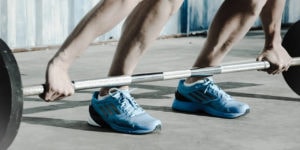Make sure you check out parts one and two in this series – eccentric training and isometric training – which should precede this final part of the Triphasic training program.
Most ruggers lift weights to increase their power and strength. A little extra muscle mass doesn’t hurt either. However, many of those same ruggers follow programs and use training methods that are not ideal for rugby.
Bodybuilding-type workouts are popular amongst ruggers. That’s hardly surprising as the sport of bodybuilding has had a massive impact on all aspects of strength training. But, in the same way, rugby training won’t help a bodybuilder get massive, bodybuilding isn’t the best was to help a rugger get faster, stronger, or more powerful.
This is because of the exercise law of specificity. This law dictates that you are fit for what you do. In bodybuilding training, you tend to lift moderately heavy weights relatively slowly for medium to high reps.
That’s great for triggering hypertrophy or muscle growth, but not so good for increasing neuromuscular performance. If you train using slow rep speeds and moderate weights, you essentially train yourself to move slowly.
There is no denying that bodybuilders look impressive, but for ruggers, this type of training is like sticking a fancy spoiler and skirts on a compact car – all show. no go. Rugby isn’t a beauty pageant, performance is more important than appearance.
Hypertrophy training can be useful for some ruggers, for example, if you want to add functional mass to make you harder to push around on the pitch. But most rugby strength training should focus on improving performance. As the saying goes, train for strength and hypertrophy will take care of itself.
Triphasic training is one way to increase rugby performance using weights. Unlike plyometrics and Olympic lifting, it uses traditional barbell and dumbbell exercises to improve strength and power.
With Triphasic training, each periodized workout phase targets a specific type of muscle contraction:
- Eccentric
- Isometric
- Concentric
Addressing each type of contraction separately means that weak kinetic links can be targeted and subsequently eliminated, leading to greater neuromuscular performance. The focus for today is phase 3 of Triphasic training – Concentrics.
What is a concentric contraction?
A concentric contraction occurs when a muscle shortens under tension. This is the most recognized type of contraction in the gym. After all, your fellow gym-goers don’t want to know how much weight you can lower (eccentric) or how much weight you can hold (isometric). Instead, they want to know how much weight you can lift. The concentric phase of any exercise is the yardstick for your strength and is the measure of your rate of force development (RFD).
Of course, a concentric contraction does not happen in isolation. A concentric contraction is preceded by an eccentric and then an isometric contraction which activates the stretch reflex and the stretch-shortening reflex. You are only as strong concentrically as you are eccentrically and isometrically, which is why Triphasic pays equal attention to both of these types of contraction.
Concentric strength is the result of intramuscular coordination and intermuscular coordination. Intramuscular coordination refers to the fibers within the same muscle group and is the result of things like increased motor unit recruitment and rate coding. Intermuscular coordination refers to the coordination between different muscle groups and includes things like disinhibition and synchronization.
In short, to produce maximal concentric strength, you need to:
- Recruit as many motor units (groups of muscle fibers) together at the same time
- Produce multiple contractions as rapidly as possible
- Turn off inhibiting sensory organs called GTOs so your muscles can generate maximal force without shutting down
- Get all the muscles within the kinetic chain working together
These adaptations are very specialized and specific – you won’t get them if you just do three sets of ten on the leg press! Instead, you need to train as you want to perform.
Because of this, the concentric training phase of the Triphasic workout method is very different from traditional strength training methods. This phase brings together the previous two phases and is designed to maximize inter-muscular coordination, increase motor unit recruitment, and maximize RFD.
However, for concentric training to be effective, you first need to have spent time developing a solid eccentric and isometric base. If you’ve jumped forward to this stage and have not worked on those two previous phases, you need to backtrack.
How to perform concentric contractions in Triphasic training
The concentric phase of Triphasic training is also called the reactive phase. This provides a big hint on how you should perform your reps. It’s time to forget things like time under tension and controlled eccentrics. For this phase, think of each rep like a bouncing rubber ball – fast descent, minimal mid-rep pause, and rapid rebound.
To the layperson, and the average personal trainer too, concentric or reactive training looks like sloppy workout technique. But remember, the aim is not to increase muscle size or tone. Instead, the objective is to maximize neuromuscular function and train your muscles to perform better for rugby. It’s that law of specificity again.
To use this training method, apply the following guidelines to your workouts:
- Warm-up appropriately – concentric/reactive training is hard on your muscles and joints. Extra time spent warming up is never a bad idea. Use ramped sets to get your muscles and nervous system ready for the demands of your workout.
- Compound lifts – to maximize intermuscular coordination, exercises that mirror common movements are best. Squats are good, leg extensions less so.
- Rest 2-3 minutes between sets – your muscles may recover faster, but your nervous system will not. The aim is to generate maximal force, and that requires proper neurological synchronization.
- Quality, not quantity – your muscles can take a lot of punishment, but your nervous system cannot. Limit this type of training to 1-3 exercises per workout, and do not train on consecutive days. You may use different muscles from one workout to the next, but the same nervous system is involved both times.
- Don’t flog a dead horse – if you do too many reps and your rep speed starts to decrease, you are training yourself to go slower and not faster. Your last rep should be as fast as your first. If you notice rep speed decreasing, stop.
Loading parameters for concentric training
You can apply reactive training to a wide range of exercises, but the best choices, according to official Triphasic guidelines, are:
- Back squats
- Front squats
- Bulgarian split squats
- Romanian deadlifts
- Bench press
- Shoulder press
For all concentric/reactive exercises, you should:
- Adopt the proper setup position, inhale, and brace.
- Maintaining proper joint alignment, lower the weight as fast as you can – pull it down rather than just let it fall.
- On reaching the bottom of the rep, do your utmost to stop the load dead before firing the weight back up to the starting position.
- Do each subsequent rep as fast as you can, with no pause between reps.
Here are two example workouts using the concentric Triphasic training method. Not all exercises involve concentrics. Other exercises are included for muscular balance and variety. Use the loading/tempo/volume that is appropriate to your current phase of training.
Lower body concentric workout
Upper body concentric workout
If you’ve been hitting the weights for a while and are ready for something new, Triphasic training is an excellent choice. Unlike general strength training, it is designed to harness and improve the power of your nervous system, and not just build non-functional muscle size. That said, if you are stuck in a hypertrophy rut, Triphasic training will probably add some mass to your frame too.
However, as effective as Triphasic training undoubtedly is, it’s also a high-stress training method. All three phases place a tremendous strain on your muscles, joints, and connective tissue. This is not a workout system for beginners or banged-up ruggers. But, if you have a solid strength training background, and robust enough to tolerate the workouts, Triphasic training has the potential to boost strength and power more than any other training method around.


